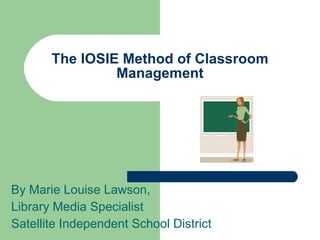
IOSIE Presentation
- 1. The IOSIE Method of Classroom Management By Marie Louise Lawson, Library Media Specialist Satellite Independent School District
- 2. Overview Theoretical Models – Behavioral – Psychodynamic – Environmental – Constructivist The IOSIE Method defined The Classroom Management Control Spectrum – Consequence Model – Group-Guidance Model – Individual-Guidance Model
- 3. Theoretical Models •As defined by Danforth and Boyle, four models of human behavior that are frequently used in case analysis Behavioral – Student behavior is based on external variables – Students are given positive reinforcement for correcting their behavior Psychodynamic – Student behavior is based on an emotional state or response – Students are encouraged to correct their behavior in a private meeting with the teacher Environmental – Student environment influences their behavior – Simple changes in environment, such as where a student sits, may be implemented to correct their behavior Constructivist – Individual students construct their own basis of knowledge, which alters as they experience new things – Students are asked to construct a response to their behavior and how they can correct it in the future
- 4. The IOSIE Method •Used to analyze problems with student behavior in five steps • Identify the problem • View the situation objectively • Determine the seriousness of the situation • Determine the objective you wish to achieve • Objectives should remedy the current problem and also provide a long-term improvement in student behavior • Specific, Measurable, Attainable, Results-oriented to be met in an established Time frame (SMART) • Propose a solution • Preventative and interventional: prevent or discourage behavior issues while dealing with misbehavior when it occurs • Implement the solution • Gain cooperation and support from parents/guardians, other staff and even professionals outside the classroom, if necessary • Teachers must be adaptive in the way they approach their problem • Evaluate the results • Return to your objectives: were your goals reached? • If misbehavior returns, perhaps the problem was wrongly identified and a broader objective spectrum is necessary
- 5. Classroom Management Control Spectrum There are three approaches to resolving classroom behavior problems 4. Consequence • Teacher outlines consequences for improper behavior 5. Group-guidance • The class utilizes a specific framework for penalties for violation of classroom rules 6. Individual-guidance • Teacher meets privately with misbehaving student to reach cooperative resolution
- 6. The Consequence Approach Displays the most teacher control of the three classroom management approaches Example: Kounin Effective Momentum Model – Based on the work of Jacob Kounin – Teacher actions (ie praise or disciplinary remarks) influence all students, not just the ones toward which the action is directed – Keywords: with-it-ness, Ripple Effect With-it-ness: Teachers have an instinctive feel for the activity in their classroom and can quickly identify behavioral problems – Teachers control the behavior of the students. Stopping lessons to deal with discipline issues adds to the problem Strengths of this approach: – Teacher actions affect entire classroom – Several procedures for effectively stopping improper behavior Weaknesses of this approach: – Limited to certain classroom sessions – Does not provide corrective measures to more serious problems
- 7. The Group-Guidance Approach Displays moderate teacher control of the situation at hand, allowing students to develop group dynamics and learn proper behavior Example: Peer Mediation Model – Developed by Schrumpf and Crawford on the thought that behavioral change should not be based on coercion – Nonjudgmental response by peer mediators including negotiation, reasoning and compromise – Teacher involvement limited to selecting and training student mediators and acting as monitors during the mediation process – Proactive toward specific problems and incidents Strengths of this approach: – Teaches a positive process to conflict resolution – Clear direction for how the program should be taught and monitored Weaknesses of this approach: – Time-consuming and heavily dependent on participation from teachers, administration and students
- 8. The Individual-Guidance Approach Displays the least teacher control of the three approaches, drawing from a positive student-teacher relationship Example: The Choice Theory and Reality Therapy Model – Developed by psychiatrist William Glasser – Basis in satisfying the five (5) basic psychological needs of every person: Belonging & love, power & achievement, fun & enjoying work, freedom & ability to make choices, and survival – Disruptive behavior occurs when a student’s inner needs are not met – Classroom environment must create a sense of personal responsibility that emphasizes self-evaluation and interaction – Keywords: authoritarian teacher, teacher leader Teacher leader: relies on cooperation, uses persuasion and creates enthusiasm in students Authoritarian teacher: uses punishment and reward, relies on authority and creates confidence in students Strengths of this approach: – Effective with most students, especially those with specific behavioral problems – Easy to implement, very straight-forward Weaknesses of this approach: – Teachers are less comfortable with it; they feel as though students are allowed to “get away with” improper behavior and time is taken away from class work
- 9. Acknowledgements PowerPoint Presentation created by: Marie Louise Lawson Research and Information collected from: A Case Study Approach to Classroom Management by Richard T. Scarpaci Special Thanks to: – Dr. I.M. Demanding, Superintendent – Ebenezer Scrooge, Business Administrator – The Satellite Independent School District Created for the class: Student Learning, Development and Behavior Management New Jersey City University, fall 2008 * Professor Annemarie Stoeckel
